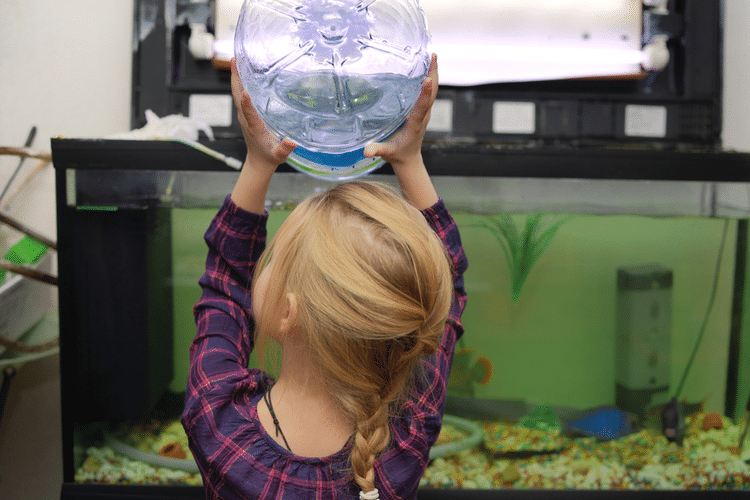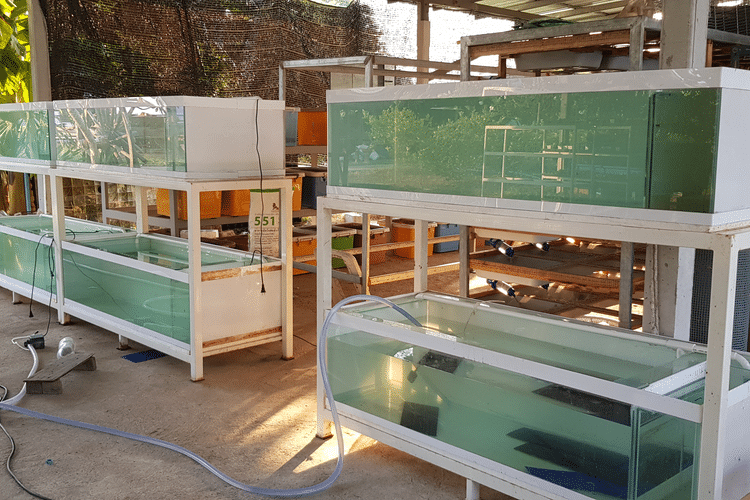Since bottled water is safe for humans, you may think it’s also safe for fish. Well, that’s not always the case! Aquarium water should be at a certain pH level and also contains hard minerals.
Bottled water can be used in a fish tank although it’s more expensive than tap water since it’ll require large volumes of bottled water to fill up a fish tank.
Is Bottled Water Safe For Fish?
Bottled water is safe for fish if it meets the required pH, alkalinity and hardness level necessary for fishes to survive in an aquarium.
Water parameters (pH, Alkalinity, e.t.c) are crucial to the care and overall health of fishes in an aquarium. They should fall within a specific range of values depending on whether it’s a freshwater or saltwater aquarium. Regardless of the type of aquarium, the basic parameters to be tested are pH, ammonia, nitrite, nitrate, alkalinity, and overall hardness. You should always test your tank and water to provide a suitable habitat for your fish.
| Parameters | Freshwater (Fish Only) | Saltwater (Fish Only) |
|---|---|---|
| pH | 6.5 – 7.5 | 8.1 – 8.4 |
| Ammonia | None | None |
| Nitrite | None | None |
| Nitrate | < 50 ppm (parts per million) | < 30 ppm |
| Alkalinity | 4 – 8 KH (carbonate hardness) | 8 – 12 KH |
| Water Hardness | 4 – 12 GH (general hardness) | 8 – 12 GH |
In addition to these parameters, saltwater aquariums require certain levels of calcium and magnesium as well. 350 – 450 ppm of calcium and 1150 – 1350 ppm of magnesium in saltwater are imperative for fish to thrive in a healthy habitat.

You don’t need to worry because testing an aquarium for these values is quite easy. Test kits you can find online or at a fish or pet store will give you reliable results for all the parameters listed above.
So, as long as the bottled water you get tests within the parameters, it’s safe to put it in your aquariums.
That said, we want to note that some brands purify their water with the reverse osmosis technique before bottling, and reverse osmosis is known to be capable of removing healthy minerals. These removed minerals might also be healthy for your fish, so it’s best to check mineral values in accordance with what your fish needs.
Additionally, bottled water can get quite expensive and might not be the most economical choice for filling up your aquarium in the long run.
Can You Use Purified Water in a Fish Tank?
Purified water means that the water is processed through reverse osmosis and deionization filters (RO/DI), and it’s recommended for fish by expert aquarists.
However, there are still certain things to keep in mind. In RO/DI, water travels through a semi-permeable RO membrane that filters out contaminants bigger than 0.0001 microns. After that, a deionization filter breaks down and demolishes all the TDS (total dissolved solids) before they can make their way to the water.
Although the result is a body of water completely free of pollutants and contaminants, zero TDS isn’t good for fish. Ideally, a TDS level between 400 – 450 ppm should be maintained to ensure that fish can thrive.
Moreover, as we’ve already mentioned, the RO process removes healthy minerals. Since minerals like calcium and magnesium are crucial for fish to thrive, they must be re-introduced to the water. Thankfully, many great RO systems like the Aquasana Rhino H20, feature state-of-the-art remineralizers. Remineralizers introduce healthy minerals back into the water, helping your fish to stay healthy.
Can You Put Tap Water in a Fish Tank?
Yes, you can use tap water in a fish tank. However, you should test it to ensure it meets the necessary water parameters (pH, alkalinity, e.t.c) for fish survival in an Aquarium.
Tap water quality varies depending on location, and the fact that it’s mostly treated with chlorine or chloramine makes it necessary to test it before putting in an Aquarium.

According to the EPA, the chlorine levels found in tap water shouldn’t surpass 4 mg/L to make it safe for consumption. Although no water supplier uses that much of the chemical, 1-3 mg/L of it can still be found in the water systems across the USA.
However, these levels are safe only for human beings. On the other hand, fishes might start dying even in waters with a chlorine concentration of just 0.05 mg/L. So, it’s important to test your tap water and reduce the chlorine presence down to 0.002 – 0.003 mg/L, which is ideal for aquariums.
Chloramine isn’t bereft of its risks for the fish either. It’s not a naturally found element, so it has to be formed through a chemical process that brings together chlorine and ammonia, the latter of which should never be present in aquariums. Therefore, if there’s any chloramine in the water, it’s best to remove it completely. Ensure that your removal method doesn’t just break it down to its components since, in that case, ammonia will still be present in the water.
What Kind of Water is Best for a Fish Tank?
Out of the three options we presented above, the most suitable water type for a fish tank is purified water gotten through reverse osmosis or de-ionization processes. It removes all the contaminants that can be detrimental to a fish, including chlorine and ammonia.
However, some minerals are lost in the purification process. Some of these minerals, especially calcium and magnesium, are crucial to making your tank optimal for the fish. So, you need to add them back to the water. You can do that by using mineral salts you can find online or at fish stores. Mineral drops, tablets, powders, and even alkaline pitchers can also work. However, it’s important to conduct regular tests during the mineralization process to ensure that you don’t under or overdo it.
Conclusion
Bottled water might be used in fish tanks as long as its parameters are within the ideal range for fish to thrive. However, using bottled water can increase the costs of taking care of your aquarium, especially if you have a big aquarium.
Tap water, on the other hand, might have high concentrations of disinfectants such as chlorine and chloramine, which is deadly for the fish. So, you should treat it before using in a fish tank.
When you treat tap water with RO/DI systems, you’ll end up with purified water that’s safe for the fish. However, these systems can destroy healthy minerals during the purification process, which can affect the growth of fish negatively, so you’ll need to add these minerals back to the water.
